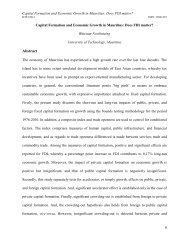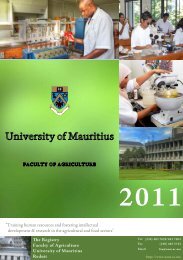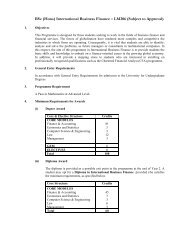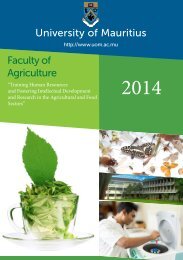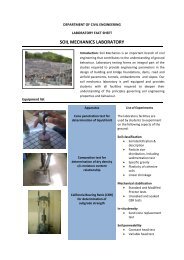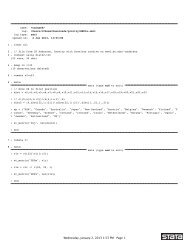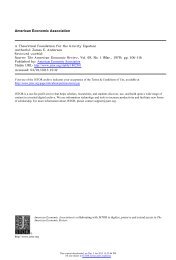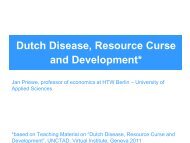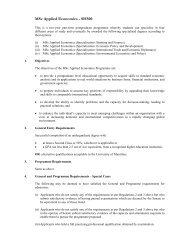SACU Revenue Sharing Formula - the University of Mauritius
SACU Revenue Sharing Formula - the University of Mauritius
SACU Revenue Sharing Formula - the University of Mauritius
You also want an ePaper? Increase the reach of your titles
YUMPU automatically turns print PDFs into web optimized ePapers that Google loves.
ICITI 2012 ISSN: 16941225If one considers <strong>the</strong> time period over which Leith (1992) was undertaking his analysis i.e.1985-1988 it is clear from chart 1 that <strong>the</strong> tariff equivalent was at a very low level, averaging11% tariff equivalent over <strong>the</strong> years covered by Leith‟s analysis. Leith (1997) later recalculated<strong>the</strong> net price raising effect <strong>of</strong> <strong>the</strong> tariff in 1997 assuming a 25% decrease in <strong>SACU</strong> tariffsresulting from <strong>the</strong> Uruguay Round commitments and found that under <strong>the</strong> 1969/1976 formulaBotswana would actually gain 1% <strong>of</strong> GDP. It is perhaps worth noting that following substantialdecreases in <strong>the</strong> <strong>SACU</strong> tariffs at <strong>the</strong> end <strong>of</strong> <strong>the</strong> Uruguay Round and <strong>the</strong> 2002 renegotiationBotswana was receiving 9.25% <strong>of</strong> GDP in <strong>SACU</strong> transfers in 2009. The more recent work on <strong>the</strong>economics <strong>of</strong> <strong>the</strong> <strong>SACU</strong> revenue sharing formula is by Flatters and Stern (2006). These authorsaddress <strong>the</strong> two key criticisms that <strong>the</strong> BLNS have historically leveled at <strong>the</strong> <strong>SACU</strong> agreement.The first is <strong>the</strong> question <strong>of</strong> price escalation and second, <strong>the</strong> question <strong>of</strong> structural polarization.Flatters and Stern (2006) undertake a similar, though by no means identical analysis to that <strong>of</strong>Leith (1992) for 2006 and find that <strong>the</strong> BLNS are more than compensated by customs transfersfor any possible cost raising impact. They <strong>the</strong>refore argue that <strong>the</strong> BLNS are net beneficiaries <strong>of</strong><strong>SACU</strong>.This argument ignores <strong>the</strong> fact that <strong>the</strong> counterfactual that Flatters and Stern (2006)propose for <strong>the</strong> BLNS i.e. imposing tariffs on imported products is, as discussed above, simplynot legally possible under <strong>the</strong> terms <strong>of</strong> <strong>the</strong> SADC FTA 37 . This legal obligation was entered intoin 2000 and implemented by 2008 and hence <strong>the</strong> authors were well aware <strong>of</strong> its existence.Therefore, in <strong>the</strong> absence <strong>of</strong> <strong>SACU</strong>, <strong>the</strong> BLNS could only impose tariffs on non-SADC membersbut for <strong>the</strong> tariff to be revenue neutral given that a country like Botswana which only sourcessome 10-20% <strong>of</strong> imports from outside SADC, such a tariff would certainly violate <strong>the</strong> country‟stariff bindings at <strong>the</strong> WTO 38 . This is more than a mere legal issue as <strong>the</strong> imposition <strong>of</strong> tariffs on awide scale would also undermine SADC and leave South Africa without <strong>the</strong> market access into<strong>the</strong> very region where its non-mining exports do have a considerable commercial advantage.Polarization EffectsThe second source <strong>of</strong> compensation to <strong>the</strong> BLNS has been <strong>the</strong> polarization effect <strong>of</strong> <strong>the</strong>customs union whereby industry becomes concentrated in Guateng. It is important to note thatpolarization will naturally occur between large and small countries and regions due to <strong>the</strong>economics <strong>of</strong> agglomeration 39 . The extent <strong>of</strong> polarization in <strong>the</strong> <strong>SACU</strong> region is reflected in <strong>the</strong>intra-<strong>SACU</strong> import figures presented in Table 3 below. These show that South Africa‟s share <strong>of</strong>total intra-<strong>SACU</strong> imports was less than 9% <strong>of</strong> <strong>the</strong> total for 2008/9, <strong>the</strong> most recent year for whichintra-<strong>SACU</strong> trade data was available. In 2008/9 South Africa exported approximately ZAR 80billion to <strong>the</strong> BLNS.Table 3: Intra <strong>SACU</strong> Imports ( ZAR Million )INTRA-<strong>SACU</strong>2002/03 2003/04 2004/05 2005/06 2006/07 2007/08 2008/09IMPORTSBotswana 17,165 16,520 19,083 16,879 18,233 25,253 31,898Lesotho 8,073 7,928 8,358 8,483 9,638 9,246 10,246Namibia 13,943 16,587 13,543 15,336 17,368 23,205 26,548South Africa 7,045 13,099 15,162 13,424 13,598 14,770 14,809Swaziland 12,453 10,937 10,266 10,667 10,195 9,220 10,814Total 58,679 65,071 66,413 64,789 69,032 81,696 94,316Growth rate - 10.9% 2.1% -2.4% 6.5% 18.3% 15.4%14




